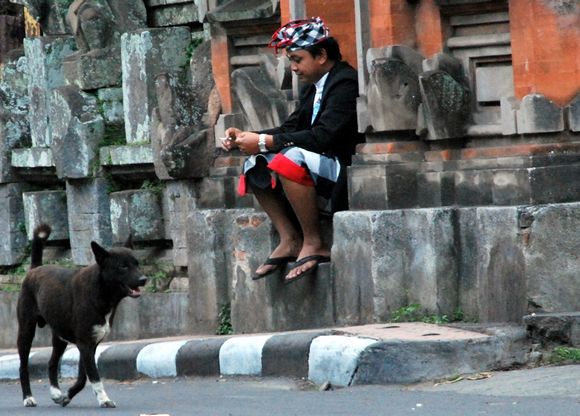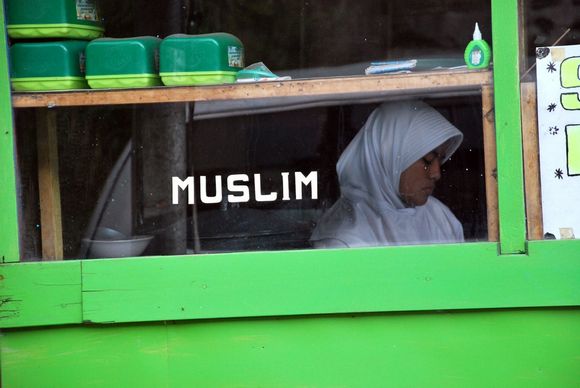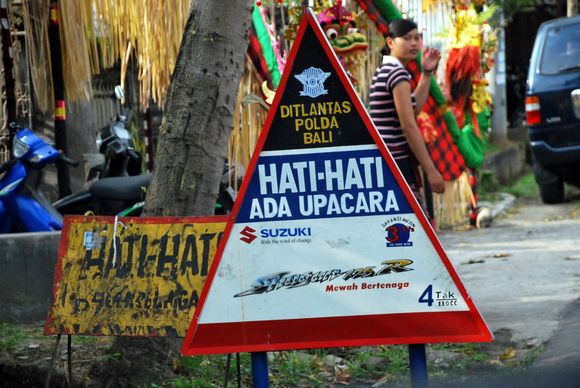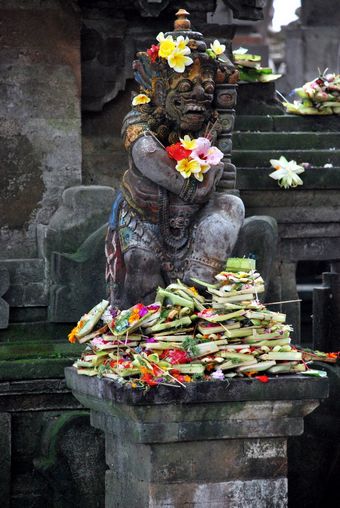Hindu-Muslim tensions have mounted, but not to boiling point
Lene Pedersen
Bali is famed for its Hindu culture, but has many Muslims tooMila Shwaiko |
In 2002, when Islamic fundamentalists blew up two nightclubs in the Balinese tourist hub of Kuta, killing and injuring hundreds, many thought this would be the trigger for communal violence to erupt on Bali, as it has on so many surrounding islands. Add the economic impact of drastic drops in tourism and a growing number of Muslim migrants, and we might indeed have anticipated an outbreak of violence on this island, otherwise so persistently marketed as the quintessential harmonious tropical — and Hindu — paradise.
However, although Hindu-Muslim relations have become more complicated in Bali in recent times, there are many institutions that prevent escalation into violence.
A plural society
Bali is renowned for its identity as a Hindu-Buddhist island in the Indonesian archipelago, the world’s most populous Muslim nation. Yet Bali in fact has a substantial Muslim minority. Muslims residing in rural areas are usually descendants of long-standing populations, with origins in Java, Madura, South Sulawesi (Bugis), Lombok (Sasak), or elsewhere in the Indonesian-Malaysian region. These Muslims — who have long histories in Bali — are known as Bali Slam, or Bali Muslims, and have assimilated to Balinese identity. They are culturally Balinese. A few live in predominantly Muslim villages, but most live in mixed Hindu-Muslim communities.
As the last published census of 2000 revealed, meanwhile, the number of Muslims in Bali has grown quite dramatically in a short time. In that year, 9.7 per cent of the island’s population was Muslim, up from six per cent less than a decade earlier.
Most of the new arrivals are migrants from neighbouring islands who come in search of jobs. The increase may be associated in part with the growing tourism industry and its labour needs, but their numbers also escalated during the Asian financial crisis of the late 1990s, when Bali fared better than most areas of Indonesia. Bali is attractive, moreover, because it is considered one of the safest parts of Indonesia by Indonesians too. The new arrivals have settled mainly in the urban areas of southern Bali, where they serve as a cheap labour force. Accordingly, the percentage of Muslims in these areas, an estimated 17 per cent, is higher than average.
There have been signs of growing antipathy towards Muslim migrants and of social phenomena associated with escalation toward violence elsewhere in Indonesia
In response to the flow of newcomers, the City of Denpasar has initiated regulatory policies, including a ‘guarantee system’ that requires newcomers to pay a deposit to ensure they will depart if they do not secure jobs. In a Bali Post survey of 250 persons in 2000, 87 per cent agreed with this policy and 74 per cent thought that other areas of Bali should adopt it too. Almost all — 97 per cent — thought it necessary to enact a regional law to regulate the in-migration of people from other islands. The survey also revealed a loss of sense of safety, an otherwise prominently promoted concept in Bali. Only 21 per cent of respondents still believed that Bali was ‘safe’.
In the context of this demographic change, though the violence that many thought might happen in the aftermath of the Bali bombing has not materialised, there have been signs of growing antipathy towards Muslim migrants and of social phenomena associated with escalation toward violence elsewhere in Indonesia.
Growing antipathy
Anyone who has spent time on Bali will know that it is not new for locals to look askance at migrants and blame them for the island’s social ills. Faced with incidents of theft, for example, people point out with conviction that these are ‘surely’ carried out by people from outside of Bali. It is a readily expressed assumption that Balinese don’t do bad things: after all, Balinese believe in karma, what has been referred to as the law of moral causation or, more simply, that one’s deeds shape one’s life. Crimes, then, must be committed by people from outside of Bali, generically referred to as ‘orang jawa’ (Javanese) — not to be confused with ‘tamu’ or guest, the term reserved for tourists, a sort of foreigner given a much warmer welcome. But although derogatory speech and other targeting of orang jawa was never unusual, it is more frequent and vehement now. Clearly something is stirring.
One shift is toward a more public projection by media and political leaders of migrants as undesirable elements. One day before the Bali bombing, the Bali Post printed an assertion that a crime was committed in Bali by a migrant every one-and-a-half hours. In his recent book, Bali: An Open Fortress, Henk Schulte-Nordholt points out that months previously, the vice-mayor of Denpasar, had told the public that ‘most of these people [migrants] are jobless…. They are criminals. There are problems with housing and traffic jams are getting worse. These people produce a lot of waste; they make slums.’
Schulte-Nordholt also notes an entertaining priest-cum-TV host, who serves up catchy quips on his popular television chat show, such as ‘Many Balinese sell their land in order to eat lots of sate…, but don’t forget that many immigrants sell sate in order to buy a lot of land.’ In this case, he’s referring both to one common occupation of many migrants (street food vendors) and to the common perception among Balinese that locals are being pushed off their own land.
Not only has public expression of such sentiments increased, but also increasingly actions are taken against migrants. It has become more difficult and expensive to obtain a migrant identity card, with some effect toward discouraging new arrivals, and also legitimising razia (‘sweeps’) by government and village officials. These sweeps may take the form of roadblocks set up by armed village patrols. Sometimes they involve officials entering migrants’ homes. They usually take place after nightfall, adding to their terrifying aspect.
Again, at least the roadblocks are not an altogether new phenomenon (I experienced one on my first visit to Bali in the early 1990s when, in the wake of a spree of thefts of sacred objects from temple shrines, Javanese were blamed). But village guards have become more prominent since October 2002, with patrols checking identity cards and quizzing the intentions of anyone suspected of not being Balinese.
 |
A more vigilant society: a pecalang, or traditional security guard, outside a temple in UbudMila Shwaiko |
Such ‘precautionary’ measures are intensifying in Bali’s rural areas too. Notably, in the 2000 Bali Post survey, 69 per cent of respondents thought that the local village councils, on their own initiative, had taken appropriate measures to ensure the safety of their territories. Following the 1999 enactment of Indonesia’s decentralisation law, which devolves government authority to local districts, a 2001 Balinese provincial regulation further strengthened the traditional village, including the traditional security forces. By the end of 2002, even remote villages focused initiatives on curbing Islamic radicalisation and limiting Muslim in-migration.
For example, such villages may seek to prevent sale of land to outsiders, a process sometimes referred to as keeping out ‘the dumpling soup (bakso) vendors’, a popular code for Muslims. ‘You let in one and soon there will be five, and before you know it, another mosque’, observed one leader in an eastern Balinese village I’ve been visiting for years, a village which also includes longstanding Muslim populations.
Bali is notorious for its tight-knit communities. Even if someone moves in from just the next village over, they are never considered as fully belonging. Nowdays, the villages’ reinforced power is often interpreted locally as supporting their efforts to keep out Muslim migrants.
The intensification of efforts to ‘protect’ Bali is linked to a cultural revitalisation movement, in which Balinese culture-centricity has taken on renewed force. Promoted as Ajeg Bali, ‘Let Bali Stand Strong’, the movement was initiated by and continues with the strong backing of Bali’s new media mogul, Satria Naradha, heir of the Bali Post’s founder, who has expanded the business into a powerful media concern. The movement emphasises Balinese tradition, religion, and culture, but has assumed exclusivist and ethno-nationalist connotations with slogans such as ‘Bali for the Balinese’.
Counter practices and invented traditions
Anti-immigrant attitudes easily conflate with anti-Muslim ones. This is epitomised in the way that pork has become an idiom through which social tensions are expressed. Bakso was previously almost exclusively made and sold by Muslims, mainly Javanese migrants. But the dish is popular among Hindu Balinese, too, and there are now ‘Bakso Krama Bali’ vendors who sell pork dumpling soup. They are not only breaking into a lucrative market, but also deploying a most potent marker of Hindu-Muslim difference: customers can now assert their Hindu-Balinese identity in contrast to Muslims through food choices in the public market.
 |
Many Islamic migrants work in warung, or foodstalls. This one is in BedugulMila Shwaiko |
Many Hindu-Balinese have alleged to me that Islam is more ‘fanatical’ now which in turn sparks Hindus to be more fanatical. In addition to the introduction of pork bakso, another example is the new practice of people saying ‘Om Swasti Astu’ (peace be with you) as a counterpart to the Arabic ‘Assalam’ alaikum’, a phrase which is now ubiquitous in mainstream and majority Muslim Indonesian culture.
Some Balinese Hindus have also introduced the notion of making obligatory prayers three times a day. In the traditional Balinese way of prayer, there was no such tradition. Yet now Balinese children are required to pray in schools in the mornings and tourist guides explain that in Bali people pray three times a day. Prayers are also broadcast from the loudspeakers around some Hindu temples and on Bali TV (owned by media mogul Satria Naradha), mirroring the Islamic call to prayer from mosques and the broadcasting of the Islamic evening prayer by national networks.
These examples may be viewed as forms of counter practice, whereby Balinese are emulating Islamic practices to counter them and emphasise their Hindu identity in the context of an Indonesia where public culture has arguably become much more Islamic over the last decade. But when you start defining yourself in opposition to something, you’re of course also letting that which you oppose define you. And when you start matching practices, they can become competitive. This sort of dynamic can lead to rapidly escalating communal tension. To make matters worse, in Bali we are also hearing and seeing things that have sometimes been associated with outbreaks of violence elsewhere in Indonesia, such as rumours about outside provocateurs and the circulation of ‘dark letters’.
Hardcopy rumours
A few years after the Bali bombing, a man I know well, a teacher in eastern Bali, showed me a small flyer being circulated, though I have no idea how widely. It presented itself as if written by a conspirational Muslim group which was planning to overrun the island and consequently mocked Hindu Balinese for their naïve tolerance. The writing was interspersed with ‘HA, HA, HA’s’ and it mentioned places already said to be in the hands of Muslims. It projected that by 2010 all of Bali would be under Muslim control. A usually well-reasoned man, and not easily impressionable, my friend took this at face value. He believed it really reflected a secret Muslim plan to take over Bali.
‘You let in one and soon there will be five, and before you know it, another mosque’
This kind of letter — an extension of the role of rumour in written form — is a known phenomenon in Indonesia. In the reformasi period following the fall of Suharto, the circulation of such anonymous and provocative pamphlets was associated with communal violence in North Maluku, Sulawesi, Kalimantan, and Papua. In Bali, when the bombing happened, many local people accused fanatical Muslims of trying to extend religious and ethnic violence to Bali, with the larger purpose of eventually securing an Islamic state. Now these ‘plans’ are finding expression in anonymously circulated pamphlets, ostensibly authored by Muslims.
Sources of stability
At the grassroots level, then, it does seem that some of the social tensions that can prefigure communal violence are present in Bali. The impact on ordinary people’s livelihoods following the bombing, and the fact that the perpetrators were Muslims, also created a potentially poisonous social climate. Yet in fact there have been very few instances of communal violence targeting Muslims on Bali. Why is this so?
To answer with another negative, I think we can say that the absence of serious violence does not show that the erstwhile stereotype of Bali as a peaceful paradise has been proven right after all. It’s not that there is never communal or mob violence here, for there is—against suspected thieves, witches, or opponents in adat (customary law) grievances. Many people also talk quite casually of the violence they participated in or observed during the anti-communist pogroms of 1965 (which, we might note, didn’t express itself in Hindu-Muslim violence either).
Many have credited the lack of sustained or mass-scale anti-Muslim violence to the response of regional authorities and religious leaders who have discouraged acts of vengeance, including by organising mass prayers (for example, after the bombings) in explicit efforts to avoid ethnic and religious conflict. Ironically, just like the same elites’ actions against migrants, these actions in some ways reflect an interest in keeping Bali ‘aman’, safe and peaceful for the tourism that is so important for local livelihoods.
Bali’s centuries-old village institutions to organise local life are crucial to how peaceful co-existence between Hindu and Muslim Balinese is lived out
In areas with established Muslim populations, we must look as well to the long history of co-existence between Hindus and Muslims. Many Balinese distinguish between two kinds of Muslims: ‘our own’ versus ‘outsiders’. Few researchers have paid attention to how peaceful co-existence between Hindu and Muslim Balinese is actually lived out, but it appears that Bali’s centuries-old village institutions to organise local life are crucial.
All Balinese communities interact through two main forms of grassroots bodies: neighborhood associations and irrigation associations. The organising principle for the former is residential and, residentially, Hindus and Muslims are often quite segregated. The Dutch colonial government, moreover, established a distinction between customary (adat) institutions and administrative (dinas) institutions, which later was adopted by the Indonesian state. The Dutch thus separated religion from practical, governmental affairs. This distinction continues to organise relations between Hindu and Muslim communities, such that even Muslims and Hindus living in mixed communities will have separate customary associations, while participating in joint administrative ones. Though I have heard of a few exceptions elsewhere, this has been the arrangement in the mixed areas in eastern Bali where I started doing fieldwork in 1998. In all cases, I heard emphasis on mutual respect for each other’s traditions.
The arrangement of irrigation associations reflects a different principle of organisation based on water sharing. This means that any given irrigation association invariably will include members from many different neighbourhoods. A few exceptions aside, irrigation associations in mixed Hindu-Muslim rural areas are generally mixed too. How they organise themselves may vary: some elect both a Hindu and a Muslim head, while others elect only one head. But in all such cases, my informants tell me that Hindus and Muslims ‘are the same’ and ‘are close’, with connotations of friendliness and solidarity, adding, ‘only when it comes to ceremonies are there differences’. In virtually all cases, Hindus and Muslims arrange their own ceremonies.
 |
Beware, there’s a ceremony: Balinese Hinduism has become more assertive as Indonesia has become more MuslimMila Shwaiko |
One head of a mixed irrigation association with Hindu and Muslim co-leaders told me that there has never been trouble, tensions or violence between the two communities in the area covered by his association, for ‘in the event of any problem, they go to the two leaders’ and it gets sorted out. In irrigation associations the most volatile source of contention typically involves water ‘borrowing’ or theft. In such cases farmers have brought grievances to their leaders and there is no recollection of these breaking into Hindu-Muslim strife.
So, rather than complete intermingling, the peaceful co-existence between Hindus and Muslims in mixed communities is characterised by a strong live-and-let-live ethos, involving both separation and cooperation, and mechanisms for mediation. Although some Hindu village leaders are trying to prevent the future in-migration of Muslims, the same people often also speak about the importance of not excluding longstanding Bali-Muslims now, and of not polarising the village. Naturally, say Hindu-Balinese, they are more suspicious and uncertain toward Muslims, but even so, these are ‘our own’ Muslims. Such integrative rhetoric when it comes to existing Muslim populations continues to be widespread, and goes hand-in-hand with growing anti-immigrant sentiment.
The mood among Muslims
I also sense a shift on the part of Muslims, meanwhile, including a growing emphasis on the fact that though they may be a minority in Bali, they are a majority in Indonesia and a part of a broader Islamic community and tradition. Some Muslim friends have started to explicitly urge me to attend and experience Muslim weddings, for example. After all, a couple of people who knew of my research activities through the years admonished, I had been to plenty of Hindu ones. Why not go to Muslim ones as well, they now queried; they are interesting too! I had to admit that, along with most tourists and researchers who visit Bali, I had largely ignored Muslim celebrations.
Peaceful co-existence between Hindus and Muslims in mixed communities is characterised by a strong live-and-let-live ethos, involving both separation and cooperation, and mechanisms for mediation
In looking at what’s stirring on the ground, it is also significant to recognise a heightened sense of alertness and accommodation on the part of Bali Muslims. Thus, people in one mosque in eastern Bali told me that they had discussed the likelihood that, if a Hindu temple was desecrated, Muslims would be blamed. They talked about what they would do in such a case, and decided they would apologise while making their innocence clear, but still offer to help pay for damages, ‘to maintain good relations’. There were other reports, especially from the urban area of Denpasar shortly following the 2002 bombings, of Muslims not celebrating the end of Ramadan too conspicuously. Rather than spilling the festivities into public areas, they now wanted to show their consideration of others by restricting them to home or the mosque.
Reasons for optimism
My sense is that there are more reasons to be hopeful than alarmed about the potential for Hindu-Muslim violence on Bali. The firm traditions of civic village institutions regulating Hindu-Muslim interactions, and the way the communities still try to accommodate to each other, will most likely continue. Some village institutions have played a role in restricting migrant Muslims, but they can also help temper reactivity. As one elder from a Muslim community near Denpasar told a local magazine:
‘For centuries now the Hindu [neighbourhood associations] and the Bugis village have existed peacefully. This is because we have structures in place, between the elders of both communities, to talk and avoid conflict. … Emotions are not permitted to rise. We take immediate action to ensure that problems are resolved quickly and collaboratively. I learned this as a child while watching my father, and the young will learn it now from us.’ ii
Lene Pedersen (pedersenl@cwu.edu) teaches cultural anthropology at Central Washington University.












